It was our third and final day staying in the Somerset region of the UK. Today we would visit Castle Combe a traditional Cotswold village and the UNESCO heritage site, the city of Bath. A day in Bath gives the perfect opportunity to see the city’s best sights.
After our continental breakfast we checked out of the Malago guesthouse we had booked through booking.com taking our luggage with us and leaving Bristol behind. I pointed the Merc out into the Somerset countryside. One observation of this day and this trip in general is just how beautiful the rolling gentle hills and valleys of Wiltshire are. The area is punctuated by stone cottages and farmhouses which add so much character. Added to by the occasional country pub, which are a treasure of English country life.
Disclosure: This post contains affiliate links, which means I may receive a commission if you click a link and purchase something that I have recommended. While clicking these links won’t cost you any money, it will help keep this site going and me travelling. Thank you for your support.
A Day in Bath
After that wholly satisfying visit to Castle Combe, we drove south to Bath. Again the countryside was breathtaking and first impressions of Bath were good ones. I was nearly enticed by Beckford’s Tower, a 19th century tower with a very photogenic spiral staircase, but the lure of the city kept me going. Bath was to be the second city after Wells on this trip with a name that tells you exactly what it was famed for. Bath is a Roman city famed for its Roman baths. But that’s for later.
The Circus & Royal Crescent
The direction of our drive took us inadvertently to a sight I desired to see. The Circus, a circular street forming a complete ring, and enclosing a green area. The houses were completed in 1768 and built by architect John Wood the Elder. I never heard of him prior, but he did build a beautiful street, and already my liking for Bath was growing.
A few suggested turns from Google Maps and we found ourselves on Royal Crescent. Designed by John Wood Junior, and in the tradition of like father like son, these thirty terraced houses form a 150 metre long crescent. It’s a wonderful piece of Georgian architecture and was completed in 1774. For the best panoramic shot walk into the green in front. Number 1 Royal Crescent has a museum in a Palladian style Townhouse with period furnishings.




I picked a random car park close to the city, the centre seemed compact so the Avon Street car park seemed perfect. The walk into the city was short, but the streets, the buildings all exuded an air. Bath is an aesthetic city. Pillars and arcades are in the abundance. The bathing tradition of the city is maintained through the modern Thermae Bath Spa, and the Cross Bath. when we had reached Stall street I was already entranced. The streets were thronged with life, and before me now lay the Pump Room, part of the famous Roman Baths, and a restaurant.
Roman Baths- Unmissable on a day in Bath
The city centre of Bath has deservedly been a UNESCO world heritage site since 1987, and at the heart of this the Roman baths. The natural springs at its core produce water heated to 46 degrees Celsius. The Celts first used the springs, before the Roman conquest of Britain. The town became known as Aquae Sulis and from 70 ad on the town and baths grew and remained in use. The were redeveloped a number of times over the centuries. They were then lost for several hundred years before their rediscovery in the late 19th century. The baths are now housed in an 19th century building, The spring is located in a building designed by our friends the Woods.
The Tour
Entry is through an 1897 concert hall, and this immediately is awe-inspiring with its wonderfully high decorative ceilings. The tours are open from 9am to 5 in winter and until 9pm in summer. We paid £16.25 for adults and £10.25 for Nina, but its a small price. First on the tour is the terrace with its impressive Roman style statues, and your first glimpse of those green waters. The museum within has a large selection of coins, statues, skeletons, statues and other artefacts all discovered within the site. A reconstruction of the temple pediment is the focus of one room, with its centerpiece, a gorgon in honour of the goddess Sulis Minerva. Look out for the bronze head statue of the goddess.
Finally we reach the spring and the great baths. The glow of green adds to just how awesome they are. This room once stood 40 metres tall. Actors in Roman dress really give you an image of life during the times of the great civilisation. Side rooms with changing rooms, plunge pools and saunas really show you how we still take influence from the Romans in our modern spa developments. The final stages of the tour take us to the springs and a oppouruinity to taste the water from the spring. I’ve never been a fan of warm water. Exit is through the compulsory gift shop or the extravagant restaurant.







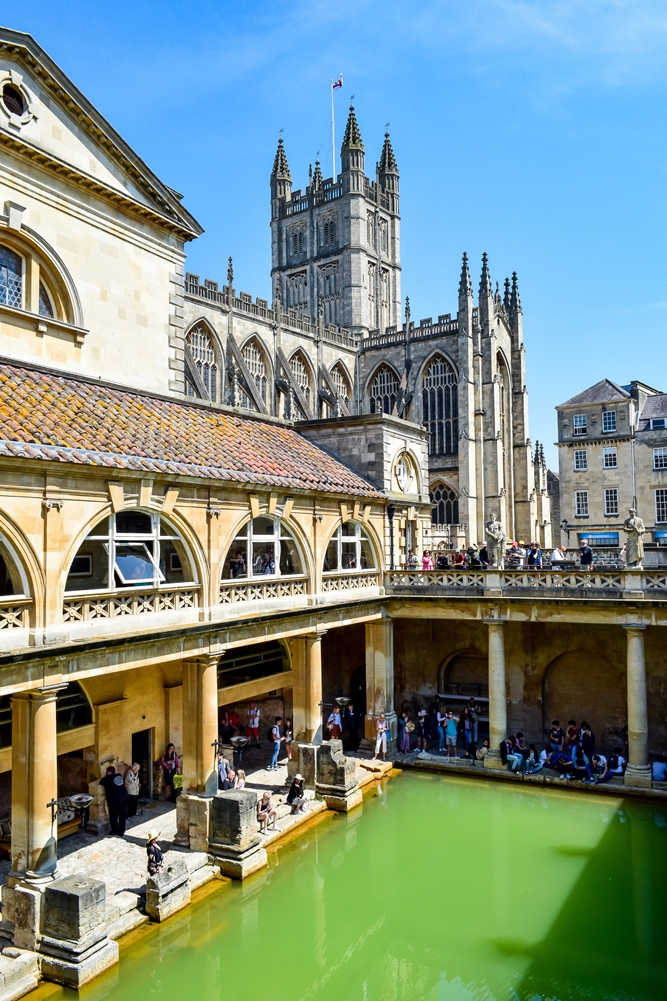



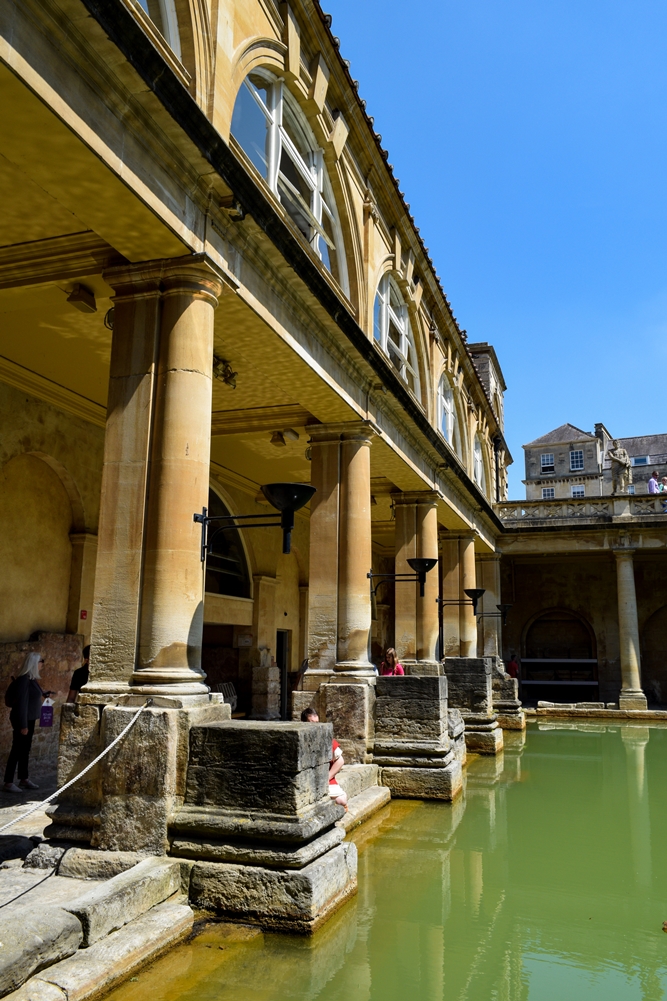
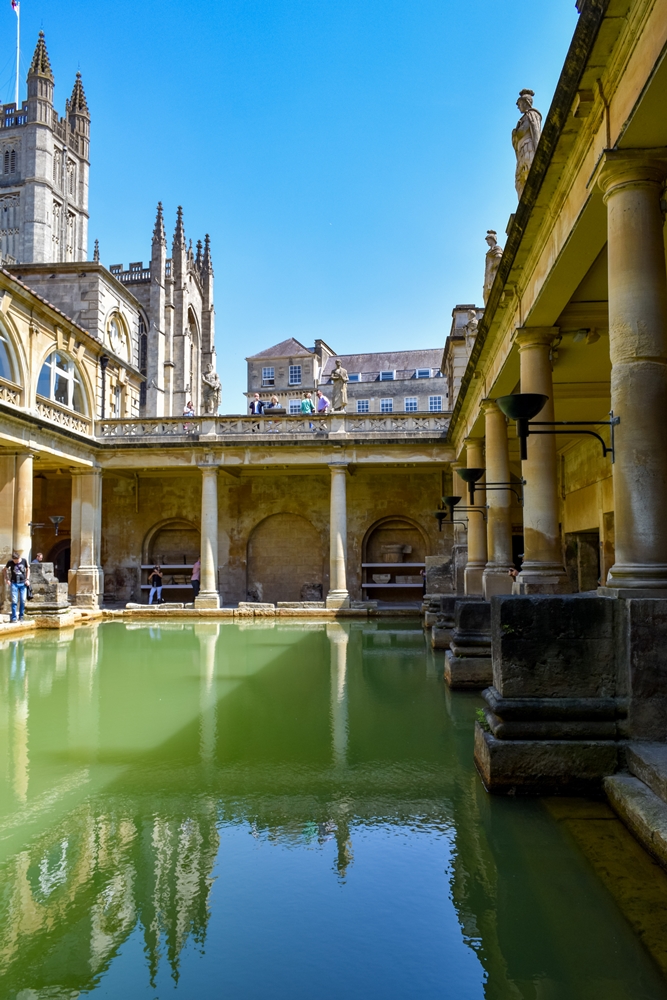

Pulteney Weir, Bath
Owing to a lunchtime concert in Bath abbey, we decided to take in the views of Pulteney Weir next on our walking tour. The city of Bath is built within a bend on the river Avon, and to prevent flooding a weir was built on the river, Whatever the reasoning they created something beautiful. The weir was given a v-shape in the 1970s, and pleasure boats can be seen cruising up the river and through the 250-year-old Pulteney bridge.
I looked longingly at the girls when I realised we could have lunch in a cafe located within the historical bridge. They indulged my whim, and so we had a couple of sub-standard pulled pork sandwiches, or cheese in Nina’s case. But they view through the window and onto the river below made up for what was lacking. On the way back after lunch we went for a stroll through Parade Gardens. Oddly they charged admission to the park, but the arrangements were nice and there were alternative views of the weir.
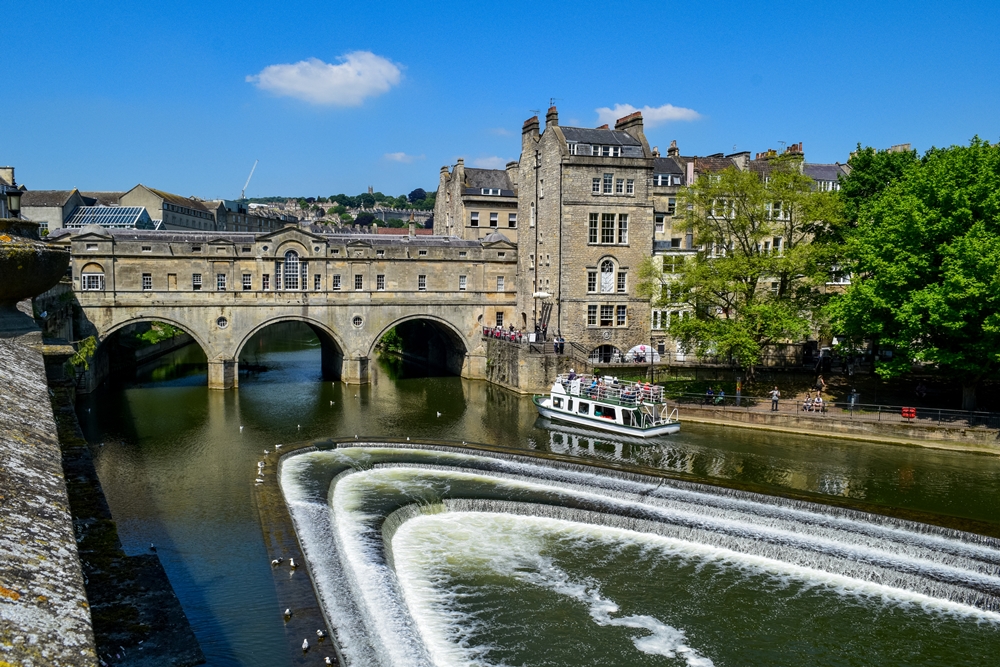
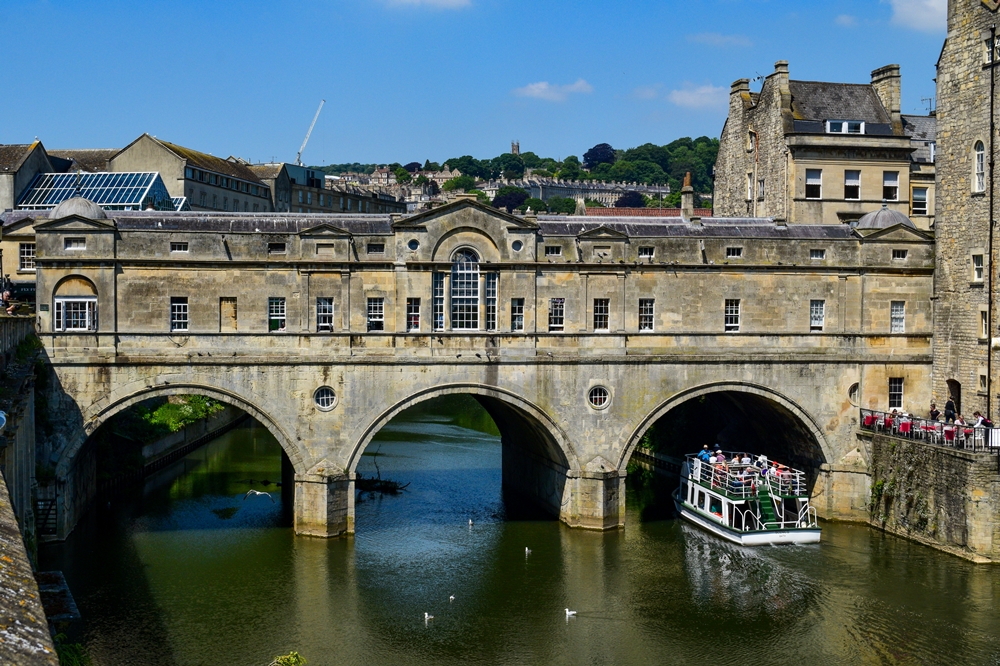

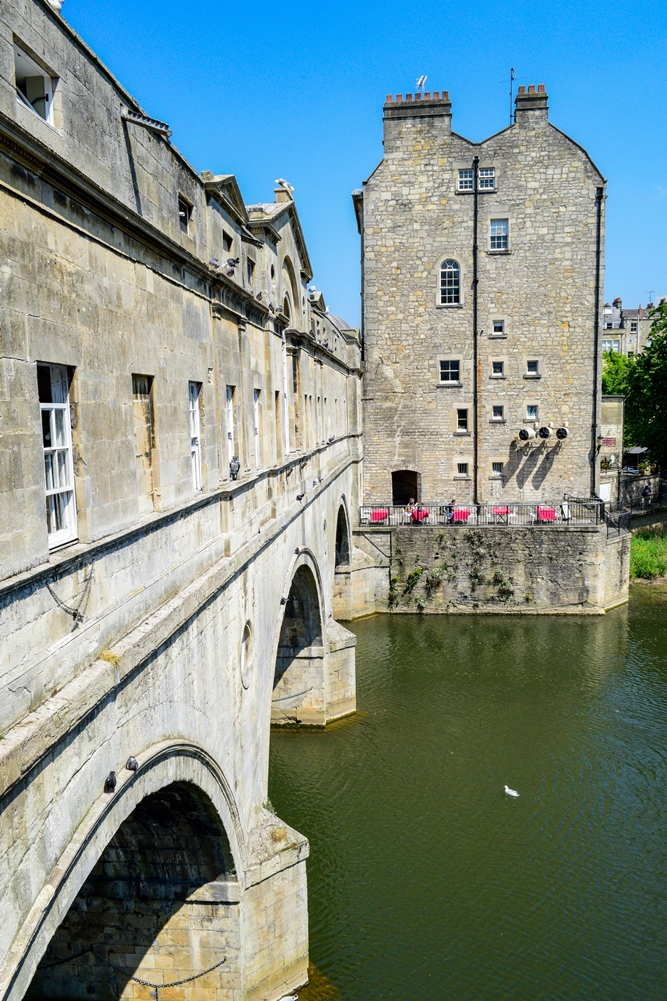


Bath Abbey
We arrived back to the city centre to see Bath Abbey. The Abbey does not charge entry but a suggested donation of £4 can be made at the entrance. The Abbey is also known as the Abbey Church of Saint Peter and Saint Paul, and has been rebuilt several times since the 7th century, the current structure is from the 16th century. It is gothic in style and has an impressive west facade with a large window and very detailed carvings. The unusually low aisles add to its visual appeal. The church is cruciform in style with flying buttresses on the north and south side.
So to the interior. The ceilings have beautiful fan vaulting and the lighting chandeliers are very unusual. The fan vaulting helps to distribute the weight of the ceiling with the aid of the flying buttresses. Very inventive these architects, and to still make it all look so impressive. The walls are covered in memorials and statues, and there are hundreds of floor stones to honour past persons. As ever in British churches the quire and stain glass windows are very attractive.
It doesn’t take long to see all the church has to offer but tower tours are offered from the gift store (of course there’s one). However much to our disappointment (probably more just mine) they were guided only and the were full until an hour later. It’s a shame as the views over Bath would have been great.



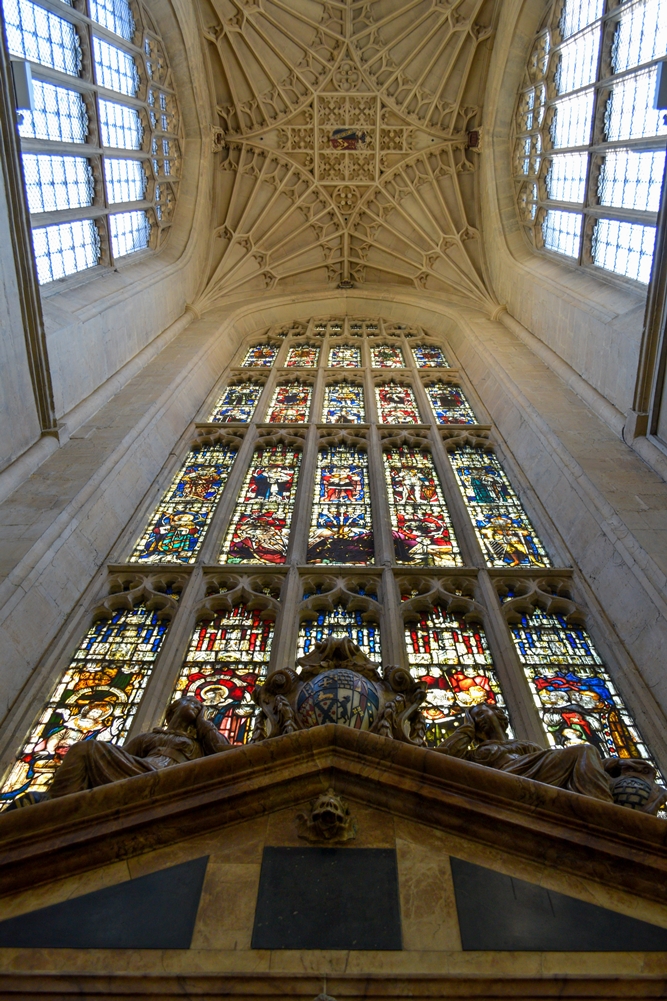

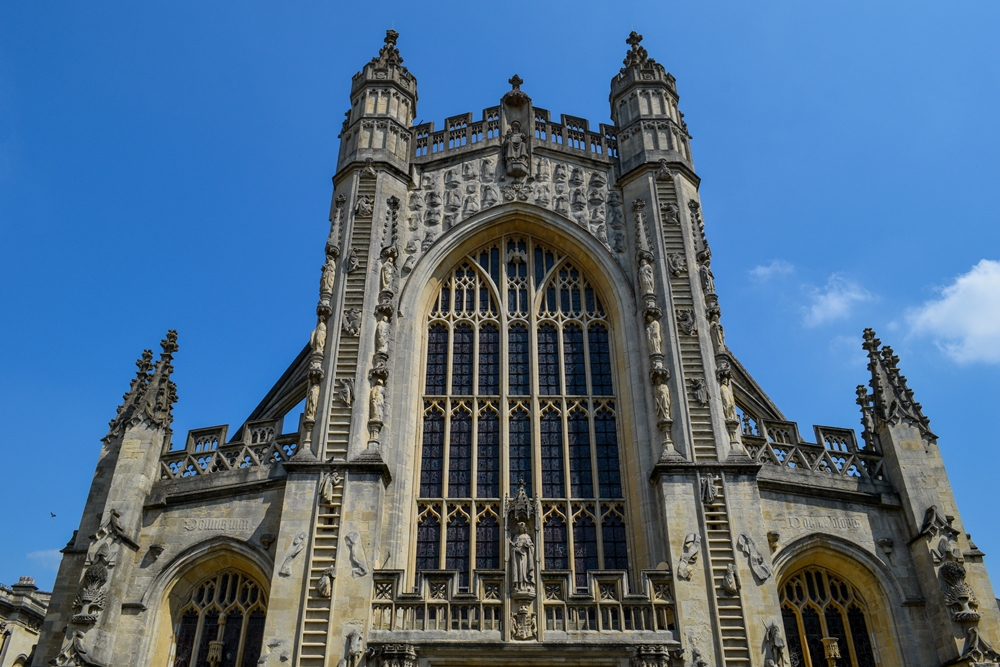
Sham Castle, Bath
Back in the car we made one more stop on our day in Bath. I’m not sure why. Located in Bath golf club is the self suggestively titled Sham Castle. It’s a bit of a sham and a complete folly, and while it looked interesting was hardly worth the effort to go out of our way. There was decent views through a clearing down onto the city of Bath in the valley below.

Our flight wasn’t until the evening so to reward Nina for being patient for the day we took her to the Airhop trampoline park which was north of Bristol. The late flight gave us plenty of time to return the car (I was sorry to say goodbye to my rental Mercedes) and have our dinner at the airport (Burger King) before our short flight home.
If you want to read more of our trip to the UK you can do so here.





17 responses
I love Stardust read the book and watched the film. The photos look great.
Thank you. I expected it to be very cheesy but I thought it was great. A bit like the village of Castle Coombe.
Pleasure it looked great I will save this post hopefully I will get to go one day.
Great post and photos. Coombe looks straight out of a fairy tale. Allan
Thank you as ever. It’s a magnificent place. So photogenic
Beautiful photos and I enjoyed reading your post.
Thank you very much Lynette. John
Excellent selection of pictures!
Thank you so much
So charming! I went to Bath when I was younger and I remember liking it.
Beautiful city. I recommend a return visit. Thanks for reading. John
Fabulous photos. I really want to visit Bath one day. It is the only Jane Austen place I haven’t been to. Looks amazing.
Its a beautiful city. I did see the Jane Austen centre on the way in, and had intended to go back for a look around, but it slipped my mind. Thanks for reading.
Well done! Your overview can help the novice and experienced traveler alike. How long have you been blogging? Have you ever travel-blogged outside of Europe? All the best, and keep up the great entries.
Thank you. I’m blogging since February of this year. I am yet to blog outside of Europe, I have a planned Morocco trip for next year so that shall be my first. Next year I plan more far flung trips but destinations are yet to be decided. Thanks for reading
Enjoyed reading that. We absolutely love the Cotswolds and usually visit there several times a year. Castle Coombe is awesome. Our favourites are probably the Slaughters, Snowshill, Broadway, and Chipping Campden. Bath is fabulous too, even though the actual spa was a huge disappointment to us.